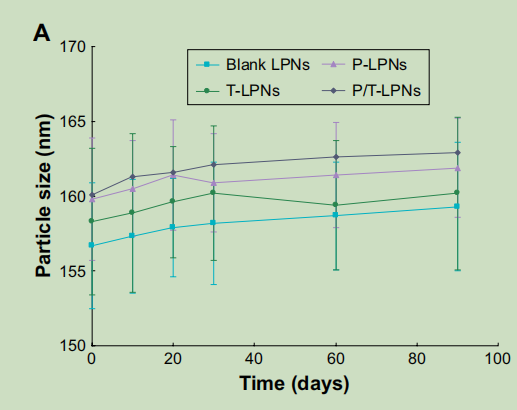文献:synergistic combination therapy of lung cancer using paclitaxel- and triptolide-coloaded lipid–polymer hybrid nanoparticles
作者:Jia liu, hao cheng, le han, Zhun Qiang ,Xinwei Zhang, Wei gao, Kun Zhao, Yangrong song
相关产品:
DSPE-mPEG5000 磷脂 - 甲氧基聚乙二醇5000
DSPE-PEG5000- FITC 磷脂 - 聚乙二醇5000 - 异硫氰酸荧光素
原文摘要:Purpose: Non-small cell lung cancer (NSCLC) accounts for the majority of lung cancer. Lipid–polymer hybrid nanoparticles (LPNs) combine the advantages of both polymeric nanoparticles and liposomes into a single delivery platform. In this study, we engineered LPNs as the co-delivery system of paclitaxel (PTX) and triptolide (TL) to achieve synergistic therapeutic effect and reduced drug resistance.
Materials and methods: In this study, PTX- and TL-coloaded LPNs (P/T-LPNs) were fabricated by nanoprecipitation method using lipid and polymeric materials. The P/T-LPNs combination effects on human lung cancer cells were studied. Therapeutic potentials of P/T-LPNs were further determined using lung cancer cells-bearing mice model.
Results: The average particle sizes of LPNs were around 160 nm, with narrow size distribution below 0.2. The zeta potential value of LPNs was about -30 mV. The encapsulating efficiency (EE) of PTX and TL loaded in LPNs was over 85%. The cytotoxicity of dual drug loaded LPNs was higher than single drug loaded LPNs. The combination therapy showed synergistic when PTX:TL weight ratio was 5:3, indicating the synergy effects of the LPNs. In vivo tumor growth curve of the experimental group was more gentle opposed to the control group, and tumor volumes of P/T-LPNs and control group were 392 and 1,737 mm3 , respectively. The inhibition rate on day 20 was 77.4% in the P/T-LPNs group, which is higher than the free drugs solution.
Conclusion: The in vivo and in vitro results proved the synergetic effect of the two drugs coloaded in LPNs on the lung cancer xenografts, with the least systemic toxic side effect.
DSPE - mPEG5000 主要由三部分组成。DSPE(1,2 - 二硬脂酰 - sn - 甘油 - 3 - 磷酸乙醇胺)是一种磷脂,它具有亲水性的头部(磷酸乙醇胺)和两条疏水性的脂肪酸链(硬脂酸)。mPEG5000(甲氧基(聚乙二醇) - 5000)是亲水性的聚乙二醇部分,其一端为甲氧基,另一端通过共价键与 DSPE 的头部相连。这种结构使得 DSPE - mPEG5000 具有两亲性,即同时具有亲水性和疏水性。P/T - LPNs 通常是由脂质和聚合物两种成分组成的纳米粒。脂质成分提供了纳米粒的双层膜结构,类似于细胞膜的磷脂双分子层,这有助于纳米粒在体内的稳定性和与生物膜的相互作用。聚合物成分可以增加纳米粒的机械强度、调节化合物释放速率等。这种杂化结构结合了脂质体和聚合物纳米粒的优点。使用脂质和高分子材料的纳米共沉淀法制备了PTX-和tl-配载的LPNs(P/T-LPNs)。

图为:示意图PTX和Tl配套的lPns
DSPE-mPEG5000在P/T-lPns制备中的应用:
采用纳米共沉淀法制备了P/t-lpn。将DSPE-mPEG5000和ISL分散在蒸馏水(水相)中。将PTX、TL和PLGA溶解在丙酮(油相)中。将油相滴加入到水相中,在室温下搅拌,直到丙酮完全蒸发。将混合物离心,除去未卸载的PTX和/或TL,然后通过注射器过滤器过滤。采用相同的方法,将PTX和PLGA溶解在丙酮中,得到含有PTX的LPNs(P-LPNs)的油相。采用相同的方法,将TL和PLGA在丙酮中溶解生产TL(T-LPNs)产生油相。用同样的方法将PLGA溶解在丙酮中生成油相,生产空白lpn。采用相同的方法制备FITC负载的lpn,用DSPE-PEG5000-FITC取代DSPE-mPEG5000。

图为:通过测量平均囊泡大小来评估lPns分散体的存储稳定性
对于各种lpn,颗粒大小在一段时间内几乎保持不变。在lpn中装载的两个粉尘的EE也保留了下来,在研究中测试的所有时间点都很稳定,表明lpn是稳定的,在一段时间内不会拆卸或聚集。采用DSPE-mPEG10000、DSPE-mPEG5000、DSPE-mPEG2000和DSPE-mPEG550进行了试验,只有DSPE-mPEG5000能形成具有均匀粒径和多分散性指数的纳米颗粒。还尝试了大豆卵磷脂、卵磷脂和油相胆固醇;有些在制备后立即沉淀或储存稳定性不会持续一周。只有ISL才能获得良好的稳定性。因此,选择DSPE-mPEG5000和ISL来制作lpn。

 2025-02-13 作者:lkr 来源:
2025-02-13 作者:lkr 来源:

